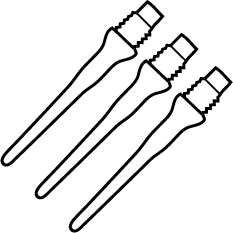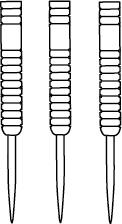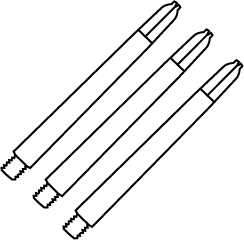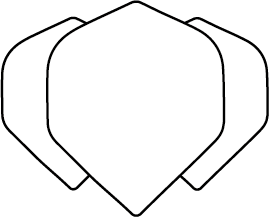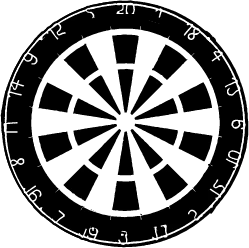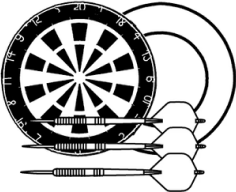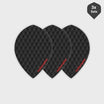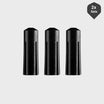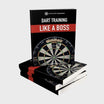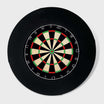In several other blog posts, we've already discussed why a darts training plan and regular training are important. In this blog post, we'd like to provide you with a concrete example of a darts training plan. First, I'd like to point out that this is a training plan for beginners who still need basic practice. Of course, this plan can be adapted and tailored to your individual skill level. It's primarily intended to serve as a starting point for how you create a training plan in the first place.
The cornerstones of the myDartpfeil Dart Training Plan
First, we'd like to start by showing you how long you can use this training plan and how often you should play it. This is basically a darts training plan for beginners, designed for a four-week period. During these four weeks, you should aim to complete a training session every other day. I'll provide you with a total of three training sessions per week. So, if you play the plan every two days, you can complete the entire game in one week.
One thing is also important here. Please create an Excel spreadsheet right at the beginning to record your results. This way, after four weeks, you can see in which areas you may have improved and where there is still potential to raise your level. You can then use this as a basis for creating your next training plan for four weeks. This gives you the opportunity to train any weak points step by step in order to eliminate them permanently. It is very important that you do not let setbacks get you down. Setbacks are part of darts, so persevere and believe in yourself!
The Dart Training Plan – Training Unit Number 1
We'll start the first training session of the week with a few basic exercises to get a feel for the dart. The general rule is, don't set your sights too high before you've warmed up properly. Every player knows that a proper warm-up is essential for darts, too, to get the right feel.
The first exercise in the plan is incredibly simple. You stand in front of the board and throw all the single darts from 1 to 20. While doing so, count the total number of darts you need for the 20 single darts. This exercise is only for throwing. However, it would be helpful to at least write down the total number of darts you needed. This way, you have a goal to always beat.

On the first day of training, we won't be placing too much emphasis on scoring . First and foremost, it's about learning to use the entire dartboard. It won't help us or you if you've mastered the 20 but otherwise have no feel for the other fields on the board. So, let's move on. After you've warmed up to the singles , the first thing we'll do is practice the doubles. Here we'll use the tried-and-tested around-the-clock method . In this game, you throw all the doubles from 1 to 20 one after the other. We'll leave out the bullseye in this plan, which is primarily intended for beginners.
The main goal of around-the-clock is to get a feel for which doubles suit you and which don't. Every player prefers different areas. The best way to find out is to write down the number of darts you need for a double.
Triple training
As a final exercise on the first day of training, you'll attempt an advanced exercise that doesn't focus on performance. Now you'll work on the triples one after the other. However, you'll only use the triple 10s to triple 20s. Again, write down how many darts you need for each field and add up the totals later. By writing this down, you can compare and evaluate your performance after four weeks and get a good overview of which fields you still need to practice.
Caution: You should take your time with the last exercise. Although there are only 11 triples you want to hit, it can still take some time.
Creating a dart training plan – Training session number 2
In the first darts training plan, you noticed that three exercises a day are completely sufficient. You shouldn't push yourself too hard. Adequate breaks are equally important to give your mind and body the necessary recovery.
In the second dart training plan, we'll focus on your scoring. This day, you'll have four exercises, each requiring exactly 350 shots. I'll keep this brief, as each exercise is the same. You throw 100 darts, or just under 34 shots, at a target. A single scores one point, a double scores two, and a triple scores three. If you miss, you don't get any points. After each shot, write down how many points you've scored in total and add them all up later.
Repeat this exercise for the 20, the 19, and the 18. Throw 50 darts at the bull's-eye . A hit in the single bull counts as one, and in the bull's-eye, as double.
As a rough guide: If you throw 100 arrows consecutively at the 20 in the first exercise, 100 points is already a challenging goal for a beginner. I think you'll be quite satisfied with 70 to 80 points to start with.
With bullseye, this is obviously much more difficult. With your 50 throws, beginners can consider themselves a good round with just 10 hits.

The last part of the dart training plan for beginners – Day 3
On the last day of training, we want to evaluate the average . Generally, beginners in particular shouldn't place too much emphasis on the average. Even if you start the leg well, the double problem can ruin the average. For this reason, we're taking a slightly different approach.
You complete the first exercise as follows: You throw 34 shots (102 arrows) and simply try to score – no matter how. You record each score in your Excel spreadsheet. At the end, you calculate the average. Of course, double shots will be missing here, but for a beginner, the average score is much more valuable.
Pressure situations can never hurt
Only after this exercise do you play 10 legs, continually recording your shots and the average at the end. This will give you a good overview of which phases are going well and which aren't. Since these exercises take significantly longer than the previous ones, this will be enough on day 3 to enjoy the following weekend. Of course, you can also add a few real matches as a third exercise on the third day, provided you have a partner. This can never hurt, because pressure is part of darts. And the best way to learn how to deal with these is in real matches.

Ready to take your skills to the next level? Discover our exclusive secrets and proven methods to optimize your game:
- Not only in the PDC professional circuit, but also in the amateur sector, the desire for a game of darts is growing. In the long run, it is less fun to throw darts alone at the dartboard. For this reason, the so-called Webcam darts currently becoming increasingly popular.
- Learn more about dart mental training and important dart mental tips to improve your dart game. Read more about dart mental training now.
Sofern nicht anders angegeben, unterliegt das im Beitrag gezeigte Bildmaterial mit Bezug zu Dartspielern und verwandten Themen dem Copyright der Professional Darts Corporation (© PDC).






